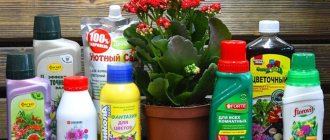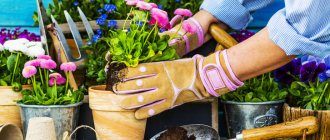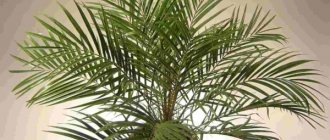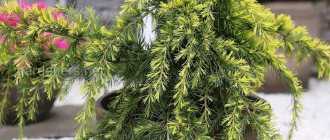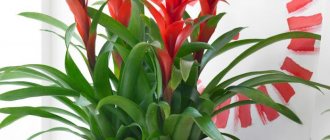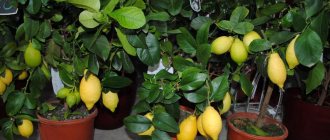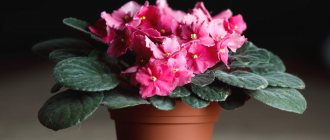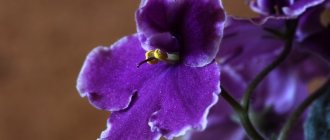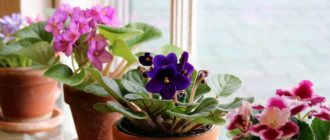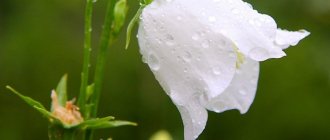Motherland
Plants with the unusual name “False palm” can be found in the tropics of various continents. They grow almost everywhere - in South and Central America, Madagascar, Australia, Southeast Asia.
In nature, these are huge plants with spreading leaves and small specimens from 35 centimeters. They are not very demanding; they have adapted to live in the shadow of other fauna.
If she grew up in an open space, she is not afraid of higher temperatures.
The indigenous population respects these plants. For them, the False Palm is the tree of life.
The roots have long been used instead of soap, and ropes are woven from the fibers of the leaves. Local healers make many medicines from plants of this species - ointments, decoctions. Shamans use extracts of some plants to perform rituals.
Flowering and fruiting
Dracaena is a perennial plant with varying heights depending on its species and variety. In the wild, trees can reach a height of up to 20 m. The tree has a woody stem, on which are sessile long linear leaves, varying in width, length and color.
Old specimens are similar in appearance to palm trees. The roots are yellow-orange. Flowering occurs rarely, with small flowers collected in panicles. The inflorescences of some species are fragrant and vary in color: cream, white, greenish. After flowering, drupes form on the peduncles. Each of them contains one seed with one cotyledon.
Description of the plant
The appearance changes as the plant matures.
The young “False Palm” has a stem densely covered with foliage. With age, the lower leaves die off and are located only at the top of the plant.
Smooth trunk and apical leaves create a characteristic palm effect.
Not all species grow up to become solitary plants. There are also shrubby forms among them.
The leaves are softer, unlike real palms. The color scheme is amazing. In some species the leaves are smooth along the edges, while in others they have spiny spines .
The root system is also different. If Cordyline has a creeping root, white with nodules , then in a plant like Pandanus the root consists of two parts . A young plant has all its roots in the ground. As they mature, aerial roots begin to grow from the bases of the leaves .
They not only decorate the plant, but also provide some support. A grown plant has a very large mass of leaves, which is difficult for a not very thick trunk to hold in an upright position. And aerial roots serve as an additional basis for the plant.
The stem also differs between species. Smooth and straight in Yucca and Cordyline, it curls into a spiral in Pandanus .
Large specimens are grown to decorate public spaces. Smaller ones are firmly established among flower growers around the world.
You can clearly see the types of plants in the photo below:
Cordilina
Yucca
Pandanus
Interesting Facts
Translated from Latin, the word “palm” means “palm”.
And this is not without reason, because the leaves of the plant really look like a large, wide-open human palm. The natural habitat of these tall trees is Africa and some regions of Eurasia and Central Asia. The climate should be warm and tropical. In total, there are about 3,500 varieties of wild palm trees in the world. Despite this, only a small proportion of them have adapted to indoor growing conditions. Plants are divided into different types according to external characteristics. Thus, fan, pinnate, single-trunk and shrub palms are distinguished.
It is also interesting that the first attempts to cultivate indoor palm trees were made in Ancient Rome. Back then, this was a sign of belonging to the upper class, since few could afford such luxury.
Home care
Caring for these plants at home is not difficult. Like all tropical plants, they are very demanding of good lighting. They do not like bright, direct sunlight.
They may get leaf burn from the sun.
The temperature in winter is not lower than 12 degrees . Water abundantly from spring to autumn, and in winter, water rarely and only with warm water. Due to the fact that false palms grow very slowly, replant them as necessary .
Main types of plants and their varieties
In the wild, the most common is Dracaena Canariana.
Dracaena Rumpha, Dracaena shootforming and Dracaena Godsefa are often found in private collections and botanical gardens. Lovers of indoor plants often grow the following types of dracaenas:
- edged (Dracaena marginata);
- fragrant (Dracaena fragrans);
- capitate (Dracaena phrynoides);
- deremenskaya (Dracaena deremensis);
- reflexed (Dracaena reflexa);
- sandera, lucky bamboo (Dracaena sanderiana);
- Golden (Dracaena goldieana).
The most common types
- Cordyline is perhaps in a special place in terms of the beauty of its leaves.
Recently, breeders have offered a huge number of these plants. With wide and narrow leaves, with colors from dark burgundy to rainbow , with a huge variety of colors. There are many forms of this false palm in cultivation. - Yucca is another false palm. An adult Yucca is an expensive plant that requires appropriate treatment.
Yuccas come in two types: without trunk - perennial evergreen shrub and with barrel - tree.Types of Yucca with a trunk: Elephantis (Elephantis), Gray. Yucca shrub: Filamentosa (Filamentous), Aloe-leaved.
Gardeners love Yucca for its flowering. If you grow Yucca at home, you will have to wait for flowering for many years. And even then it’s not a fact that it will bloom.
- Another representative of this species is Pandanus. In nature, this is a huge plant, the height of a three-story house.
From afar, Pandanus looks like a fairy-tale giant with a huge stem - a body, twisted in a spiral and many roots - legs, intricately curved.The leaves, narrow with thorns along the edges, are arranged in a spiral on the stem . In a young plant this is not very noticeable.
Watch a useful video about Pandanus below:
False and real palm trees.
19
Hello, dear flower growers! The sun is blazing hot outside. It's quiet on our site for now. Everyone's Sunday morning is planned out. Maybe people will gather in the evening. And here we are: Olya with hollyhocks, me with palm trees... Imagine my palm trees, I haven’t shown you yet. An interesting palm plant. It doesn’t bloom, but attracts attention, why? Probably because it has an exotic appearance, even at an early age it looks like a tree, and we are somehow intuitively drawn to trees. It also reminds me of warm countries, perhaps awakens dreams of sand on the seashore. On our website I see many beautiful tall palms, mine are still far from them. One of the most common palm trees is the chamedorea. Belongs to the pinnate palms. It is often found on sale. It’s attractive because there are a lot of small palms in the pot at once; flower lovers’ eyes immediately light up: I’ll plant them! I am no exception, I also bought it and of course planted it. Over time, somehow all the little ones dispersed to other houses, I only had two palms left. Now they have grown up, one is bigger:
Another smaller one:
The one that is smaller, slimmer and grows more proportionately:
The first is experimental: she also spent time on the street. I placed it incorrectly, burned the leaves, and even a mealybug crept into the house with it. As a result, she had to cut off three leaves, and I poisoned the pest on the street with an aktara, and washed it with laundry soap, and gave a shower with the fairies - I barely won. The second palm tree did not experience stress, so it grows calmly, and even bloomed this year. Another fan palm is Livistona. I got it completely by accident. They were going to throw it away because of the three existing leaves, two were completely brown, the third had dry tips and a top that showed no signs of life. Now she looks like this:
Over time, I cut off two brown leaves, and I simply carefully cut off the ends of the third. It is interesting that the leaves of this palm tree initially seem to have been partially cut off. If not properly cared for, a brown border appears at the ends (I confess, it happens to me, mother laziness!) Thanks to the site, I just read more carefully about palm trees to understand how they differ from other flowers in caring for them. The conclusions are:
-do not tolerate complete drying and flooding, in both cases the leaves will suffer - a signal to the owner;
-they really don’t like cold feet, so don’t keep it on the window in winter, and don’t put it on a cold floor, you need a stand;
- water for irrigation, even in summer, should be warm, approximately 33-36 degrees, i.e. When you lower your hand, at the first moment you feel neither heat nor cold, i.e. There is no temperature difference, the water should be approximately the same as body temperature.
Well, the false palm trees include our beloved dracaenas. They are similar to palm trees in appearance, which is why we call them that. The first dracaena that I got was a gift:
Probably she didn’t really want to give it to her, because she grows very slowly. Or maybe you need a lot of strength to feed all three of your tops. In any case, the two babies that I later bought in infancy have almost caught up with her:
I was going to, I was going to cut off the tops of them, but I never got around to it. Is it too late now? Well, another little dragon - for me a terrible whim, but so elegant that I tolerate her whims:
I looked at Lyubochka’s hoyas and there I liked the Dancing Hoya, if you look at this dracaena from above, it is also dancing, its leaves bend in different directions. So I will also call her Dancing.
All my palms and non-palms grow in palm soil. (Although they say that all the soils are from one bag, I try to adhere to the rules and correlate the soil with the plant according to the recommendations of specialists. This is how I calm my conscience, because it seems like a terrible hassle to me to compose the soil myself. I have so much respect for those flower growers who do this do). If you read to the end, then you have a souvenir - a growing bouquet:
Bye!
Indoor palm tree Howey
Palm Howea (Kentia) is one of the subspecies of pinnate palms. It is endemic to Lord Howe and not found elsewhere. There are three popular types of this palm:
- Forster;
- Large-fruited;
- Belmora.
The height in the natural environment reaches 15 meters, and the length of the foliage is up to 5. Khovea has a wide, spreading crown. The surface of the trunk consists of ring-shaped formations in the form of scars from dead leaves. Caring for the plant is not difficult. All you need to do is control soil moisture. This palm tree is often used to decorate gardens, offices, and business centers.
Indoor palm tree Howey (click on photo to enlarge).
Indoor palm tree Howey (click on photo to enlarge).
Howea does not require special care: it can remain for a long time without moisture and out of light. However, experts advise to ventilate the premises well and not to smoke near it. The usual temperature at which wild Hovei grow is within +20...+25 °C. The minimum temperature it can withstand is +10 °C.
Hamedorea
It is a deciduous plant that can bloom yellow flowers at any time of the year, has feathery leaves, thin trunks, and grows as a bush with many trunks. The palm tree has the following varieties: tall, graceful, elegans, bridble, zeifritz, single-color, tall. Each species is similar to each other, differs from all types only of Hamedorea metallica: the shape and color of the leaves, one trunk, this variety is more reminiscent of a coconut palm. The height of the plant also depends on the species, the average height of the trunk is from 1 to 2 meters, and high chamedorea can reach from 3 to 5 meters.
This species loves to be in partial shade; the palm tree should be positioned so that the sun's rays do not fall on the plant; the leaves must be sprayed, since this variety requires moist air. The optimal temperature for growth is +17 o and up to +27 o C, chamedorea loves heat very much, in winter the temperature should not drop below +16 o C.
Transshipment method
Algorithm of actions
Palm roots are incredibly sensitive to growing conditions and any injury. A careless attitude will certainly lead to the shedding of leaves and death of the yucca. How to transplant correctly so that the plant quickly comes to life? A gentle method should be used - transshipment, that is, partial preservation of the earthen clod around the roots.
The process is simple, it is important to follow a number of simple steps step by step:
- choose the right pot - 2-3 cm wider than the previous one;
- organize a drainage layer (3.5-4 cm);
- cover the drainage with a layer of fresh soil (up to 2 cm);
- place the yucca with its native earthen lump inside the pot;
- Fill the remaining voids with new nutrient soil.
All that remains is to choose a place for the plant with diffused light and without drafts. Acceptable air temperature is within 20-25 degrees Celsius.
On a note! It is prohibited to feed the plant with fertilizers immediately after transplantation!
Drainage
False palm does not tolerate stagnant water. The roots instantly rot, causing disease and death of the yucca. The presence of any inert material at the bottom of the pot for the plant is no less important than the correct composition of the soil.
The following is used as drainage:
- expanded clay fractions;
- gravel;
- pieces of foam;
- broken brick;
- coarse sand.
Shipping pots do not use drainage. Excess water flows out through many holes located at the bottom. This fact should be taken into account when watering yucca immediately after purchase.
Soil composition
The easiest way is to buy a ready-made mixture in a store. The assortment is quite wide. You should choose formulations for palm trees, cacti or ficus.
If the house has sand, a universal substrate, turf and leaf soil, you can prepare the mixture yourself, adhering to the following proportions.
| Components | ratio |
| universal substrate + sand | 7:3 |
| leaf soil + turf soil + sand + compost | 2:2:2:1 |
| leaf soil + turf soil + sand | 2:3:2 |
Watering
The main task after transshipment of yucca is not to over-moisten the soil in order to avoid rotting of the injured roots . It is better not to top up the soil than to make it swampy. It is better to compensate for the lack of moisture in the soil with additional air humidification. Then the yucca will more easily tolerate a change of environment.
Washingtonia
This is a palm plant that grows rapidly, the shape of the leaves resembles a fan, the trunk is brown, and it blooms extremely rarely in indoor conditions. The woody plant has two varieties: powerful and thread-bearing Washingtonia.
Watering should be moderate, it is worth watering when the top layer of soil begins to dry out. The optimal temperature ranges from +20 o to +25 o C in the summer season; in the winter season the temperature should not drop to 5 degrees. Washingtonia loves a well-lit room, but avoids direct sunlight and drafts; it should be fed 2 times a month with nutritious fertilizers.
Currently, specialized flower shops can provide a large assortment of indoor palm trees and indoor flowers for every taste. By purchasing a houseplant, a gardener or just a hobbyist can find a small tropical corner in which to plunge after a hard day.
Did you like the article? Share with your friends.
Brief description of the palm family
There are more than 3,500 varieties of palm trees in nature. Their homeland is the tropics and subtropics. A distinctive feature of such plants is a thick trunk and leaves collected in a bunch. There are plants with thin and long leaves, and others with wide ones. They are grown in large flowerpots, effectively landscaping a loggia or a spacious living room.
Palms are perennial trees, sometimes found in shrub form. These are mainly specimens with a non-branching trunk. The crown dimensions are quite impressive - up to 14 m in length and 2 m in width. Under natural conditions, they are found in humid forests, on the shores of the seas and at an altitude of 2000 m in the mountains. Among the valuable varieties of real palm trees, there are such species as coconut, sago, date, sugar and oil palm.
Plants that look like real palm trees are a good solution for home gardening. They are less demanding in terms of living conditions, quickly adapt to enclosed spaces and have an attractive appearance. The main thing is to follow the rules of planting and caring for them.
Liviston
A palm tree whose leaves resemble a fan, the main advantage of the plant is its rapid growth and minimal care. Livistona has a large number of varieties, but the most common are: southern, round-leaved, Chinese, beautiful, deceptive, and in total there are more than 30 species. This plant loves a humid climate, so the palm tree should be frequently sprayed and watered, preventing the top layer of soil from drying out.
The temperature at which the plant will feel comfortable is +13 o +16 o C in the summer; in winter, the temperature should not drop to +8 o C. It must be fed frequently, since with active growth, Liviston should receive enough nutrients.
What house plants are similar to palm trees?
Among the commonly found indoor plantings that have an external resemblance to a palm tree are: bocarneya, dracaena, dieffenbachia, and spurge. To decide on the choice of exotic foliage decoration for your home, you need to become more familiar with their main characteristics.
Beaucarney
An interesting indoor plant of Mexican origin has won the recognition of lovers of home floriculture due to its resistance to temperature changes, undemandingness to watering, and the ability to tolerate minor drought quite painlessly. It can be safely placed near heating appliances. The only thing is that bokarneya does not bloom indoors.
This plant is also called the “bottle tree”. It has thin ribbon-shaped leaves that are located on a thick trunk. It is better to keep it at a temperature of 10-26 °C on the windowsill of a window facing southwest or south. In summer, the flower is irrigated once every 7 days, and in winter once every 2-3 weeks. Feeding procedures are carried out from April to October - every 14 days.
Dieffenbachia
The Latin American plant is distinguished by its intensive growth rate; in just 5 years it can reach a height of 2 m. This evergreen plant has large leaf blades that are oval in shape and variegated in color. The culture does not produce flowers when grown in closed spaces. It is valued for its massive green stem and evenly growing large leaves.
The plant does not tolerate drafts and temperature fluctuations . It needs sufficient light, but it should not be exposed directly to the leaves, otherwise there is a high risk of burns. Irrigation activities should be carried out only with settled boiled water. Due to the poisonous nature of the sap, pruning the flower should be done with protective gloves.
Dracaena
The tropical guest, whose homeland is Africa, is a lush shrub with straight, sharp leaves. Its advantage is its compact size - up to 40 cm. By trimming the top part of the plant, you can add splendor. After pruning, two branches appear from one branch. From the cut top, after rooting in water, it is possible to obtain another flower.
Signs and superstitions
The tree of happiness is good to place at the entrance to the house, as a talisman for the owner and his family. The number of trunks matters: there should be 3, 5, 7, but in no case 4. This number is considered unlucky among the Chinese.
In the interior of the house, the plant will look good in the living room and bedroom, having a positive effect on the air and energy of the house. It is believed that the flower has the ability to transform accumulated negative energy at home into positive energy.
Some signs associated with keeping and growing a dragon tree:
- a sudden gift of a flower means luck in love;
- with the appearance of a plant in the owner’s room, success and luck, career growth and quick decision-making in business will await;
- Happiness bamboo brings peace and harmony to the family.
There are also sad, even scary signs:
- if the flower withers, it means that a person with negative energy has appeared in the house, or one of the household members has problems;
- the death of the tree of happiness means the death of one of the spouses. The appearance of dragon blood sap on a tree trunk means violent death.
According to Feng Shui, lucky bamboo is a very beneficial flower. It is a symbol of marriage and is given for any occasion: weddings, New Year, family celebrations. It is better to place it in the wealth zone: on the south or east side of the house.
To protect against external bad energy, flower pots are placed on the western window. For greater effect, Feng Shui masters advise tying the stems with a red ribbon.
Dracaena is an unpretentious and undemanding long-living plant. Indeed, if placed correctly, it will be a talisman for the family for many years. Phytodesigners advise placing the flower in a prominent place in the room - on the floor or low stands, using several varieties with different crown shapes and leaf colors. The priority number in the dracaena group will be 3 or 5 plants.
Indoor palm Gioforba
Giophorba palm , also called the bottle palm, grows in the island regions of the Indian Ocean. Under natural conditions, the height does not exceed seven meters. Gyophorba has a seal in the middle of the trunk. It itself is smooth, without scars or other formations. The feathery elements give the palm fan a presentable appearance. Gioforba requires careful care. The room temperature should not fall below +16 °C. It is not recommended to place it near windows on the south side.
Indoor palm tree Gioforba (click on photo to enlarge).
Indoor palm tree Gioforba (click on photo to enlarge).
Hyophorbe needs to be watered on time, and the leaves need to be wiped off dust (but not during wintering). This palm tree grows slowly and if it gets sick, the recovery process will also be long. Dried foliage will indicate deterioration of the condition. To prevent this from happening, you need to monitor the humidity in the room. You can place a container of water or an aquarium next to the hyophorba.
